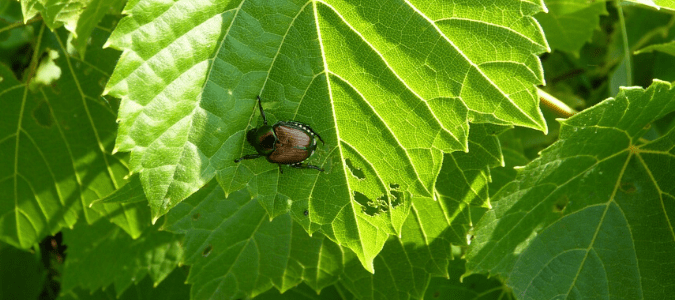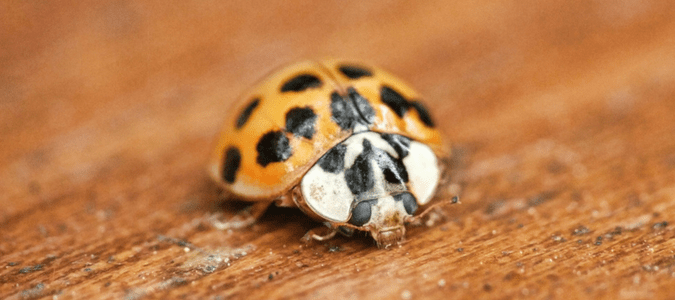
The most common type of insects are beetles. These bugs are found in nearly every type of marine and terrestrial environment, so we do see them in our lawns and gardens. When comparing the Japanese beetle vs. the ladybug, what do we need to know about which might be beneficial and which is destructive?
While ladybugs or lady beetles are among the most beloved of all insects, Japanese beetles are seen as an agricultural threat. Japanese beetles (Popillia japonica Newman) are invasive pests which feed on the fruit and leaves of many types of crops, shrubs, trees and vines. As their name suggests, these insects were brought into the U.S. in the early 1900s from Japan. These beetles have infested many of the states east of the Mississippi River and have partially infested Texas, Oklahoma, Kansas, Nebraska and South Dakota. Japanese beetles are metallic green with copper-brown wing covers and reach about a half an inch in length. If you look closely, you can spot a row of white tufts of hair from under the wing covers.
Part of what makes these pests so devastating to your yard is the fact that they like to eat in groups and will start at the top of your plant and slowly make their way down. While these bugs only live for about 45 days, they are capable of laying up to 60 eggs in their lifetime. These eggs molt into grubs and live in the soil for ten months, eating the roots of grass and vegetable seedlings. When they become adults, Japanese beetles begin eating the veins in your plants’ leaves and flowers. While it can be difficult to eliminate Japanese beetles once they have become established, homeowners can experiment with chemical controls, biological controls and habitat manipulation to get rid of these pests.
With their black-spotted backs and bold red color, ladybugs are a type of beetle that can be hard to miss, even despite their small size. Many homeowners love ladybugs in their yard because they will eat insects that will damage your plants, including aphids, mealybugs, mites and other types of soft-bodied insects. These beetles can eat anywhere from fifty to sixty aphids in a day.
Ladybugs look very similar to another insect from the same part of the world as the Japanese Beetle: the Asian lady beetle. These bugs are often orange and can bite humans under some circumstances. For that reason, many of us may want to know how to distinguish an orange ladybug from a red ladybug and how to avoid infestations of beetle pests.

Orange Ladybug vs. Red Ladybug: How Are They Different?
Asian lady beetles and ladybugs may look similar, but if you know what to look for, you can distinguish between these two insects. Lady beetles and lady bugs have other distinctive factors, including behavior, life cycles and habitats. Most importantly to homeowners, one type can more likely to make its way inside your home and cause trouble.
Appearance
The more common of the two types of insects is the ladybug. Ladybugs are native to the United States and have oval, dome-shaped bodies, with six short legs which are hidden under their shells. Bright red tends to be the most prevalent color of this beetle in this country; some, but not all, ladybugs have multiple black spots on their backs.
The Asian beetle, Harmonia axyridis, was introduced in the 1960s by the Department of Agriculture to control agricultural pests. Though the Asian lady beetle has many similarities to the ladybug, this insect’s color is often different, ranging from a mustard yellow to black, with orange being the most common. Another distinguishing characteristic is that the Asian Beetle typically has more spots than its native counterpart—19, to be exact. That said, some Asian beetles don’t have any spots at all. Most of these invasive insects have small, black markings on the whitish area on the head which resemble an “M” or a “W.” Asian beetles are larger than American ladybugs, often measuring one-third of an inch in length.
Diet and Behavior
Both ladybugs and Asian beetles are omnivores. Despite its small size, a ladybug can eat up to 5,000 insects in its lifetime.
Most people association ladybugs with childhood memories and their overall harmless nature. Gardeners and farmers appreciate both ladybugs and Asian beetles because of what they like eating. Both types of insects seek out aphids, plant-eating insects and other soft-bodied insects which can cause damage to crops.
Life Cycles
The life cycle of both ladybugs and lady beetles is made up of four stages: egg, larva, pupa and adult. But while the complete transformation of a ladybug takes between one to two months, Asian beetles take only three to four weeks to reach adulthood. The Asian beetle depends on a particular combination of rain, natural food sources and the right temperature to mature.
Asian beetles lay their eggs in either clusters or rows on the underside of trees, leaves or crops. Ladybugs deposit their eggs on plants that offer a food source. Beetles lay fewer eggs which hatch in a shorter period of time as ladybugs. This helps explain why the numbers of Asian beetles have grown, especially because these insects have few natural enemies.
Preferred Habitat
Ladybugs can be found in many different habitats, including grasslands, forests, cities, suburbs and along rivers. Asian lady beetles prefer tree-dwelling habitats and can be found infesting both ornamental and agricultural crops.
Both the ladybug and lady beetle are most active during the warmer months of the year and seek shelter when the temperatures begin to drop. During the cooler months, you can find them under rocks, inside logs and in the walls of your homes. Both species tend to form clusters—up to 1,000 bugs at times—before they seek out warmth. The ladybug and Asian beetle hibernate throughout the winter and become active again in the spring.
Managing A Japanese Beetle Ladybug Infestation
In the months leading up to fall, Asian beetles begin to leave summer feeding sites in search of safe spaces to spend the winter. This phenomenon can lead to home infestations as these creatures seek protection inside and around buildings. Beetle movement tends to occur after periods of chilly weather when the sun is out. These flights tend to take place in the afternoon. Industrial areas and wooded residential neighborhoods are most at risk for an infestation.
Asian beetles are often drawn to sunny exterior walls, so they tend to avoid shady spots. The insects are attracted to color contrasts, so you may also find them where light and dark colors converge, such as near where light window trim meets a darker house color. Homes near dense vegetation, such as forests or fields, tend to see more Asian beetle home infestations.
When temperatures begin to climb in the late winter and early spring, Asian beetles begin to become active. Awakening beetles sometimes make their way indoors as they make their way out from your attic, walls and baseboards. You may also notice the beetles near windows and light fixtures since the insects are drawn to light.
The impact of these beetles on humans is relatively minimal. Some studies suggest that infestations can trigger allergic reactions. In addition, an Asian beetle can release an unpleasant odor from its legs when threatened. The yellow fluid that often accompanies this odor can stain walls and fabric. The best way to avoid an Asian beetle infestation is to keep them out from the start. Close off any gaps and cracks around the exterior of your home, and be sure to seal doors, windows and any openings around pipes properly.
For large infestations, homeowners may find that their own DIY efforts are largely ineffective to remove these pesky pests. Indoors, the best way to remove beetles is by using your vacuum. Treatments can be applied indoors and around your home’s exterior to deter these pests. Light traps can also be a way to remove these beetles from your home. A pest professional can recommend what steps to take to manage an infestation and to prevent future pest problems.
What To Do About An Orange Ladybug Bite
Asian beetles can bite humans with enough force to break the skin, although pain tends to be minimal, in many cases not as painful as a carpenter ant bite. Dogs can suffer more from a red or orange lady beetle bite. Although uncommon, many Asian beetles can become lodged inside a dog’s mouth, which can cause ulcers and discomfort. Since pet owners don’t regularly look inside a dog’s mouth, f your pet stops eating or if you notice foaming at the mouth or drooling, your dog may be the victim of beetle bites. While pet owners can usually remove these beetles at home, you may want to consult with your vet about any recommended treatment or further care.
ABC Can Help You Manage Pest Problems
Most homeowners are unable to identify and distinguish between the many types of insects that may come into their yards and homes. Whether it’s beetles, roaches, termites, fleas or other insects, the experts at ABC Home & Commercial Services can identify the source of your problem and come up with a solution to rid your home of pests. ABC’s pros can take care of your pest problems so you can get back to enjoying your home.
